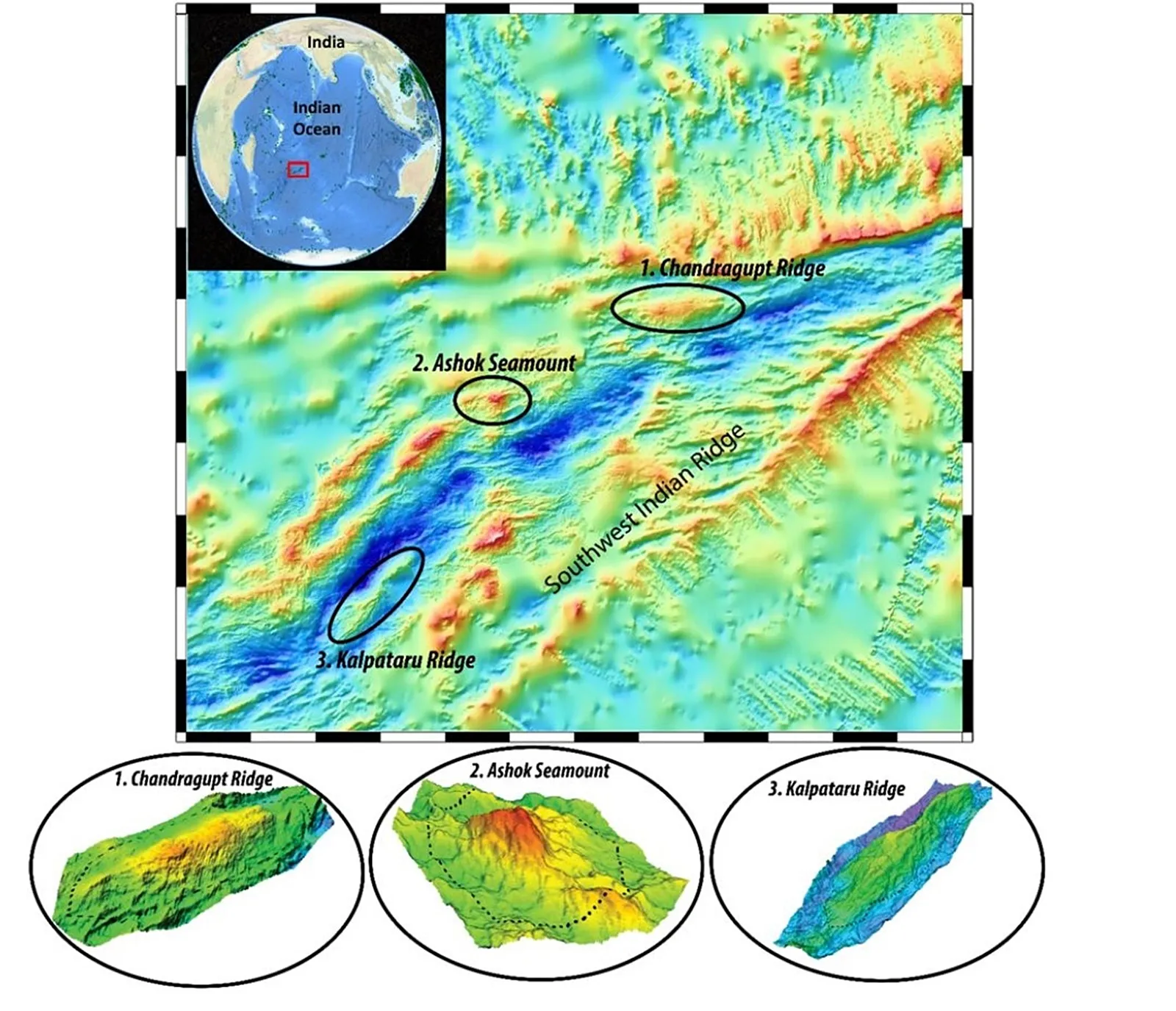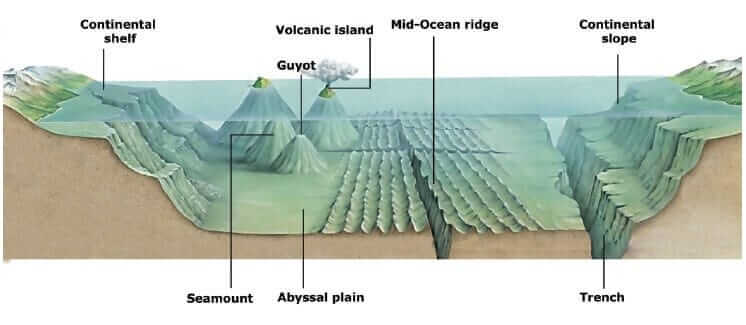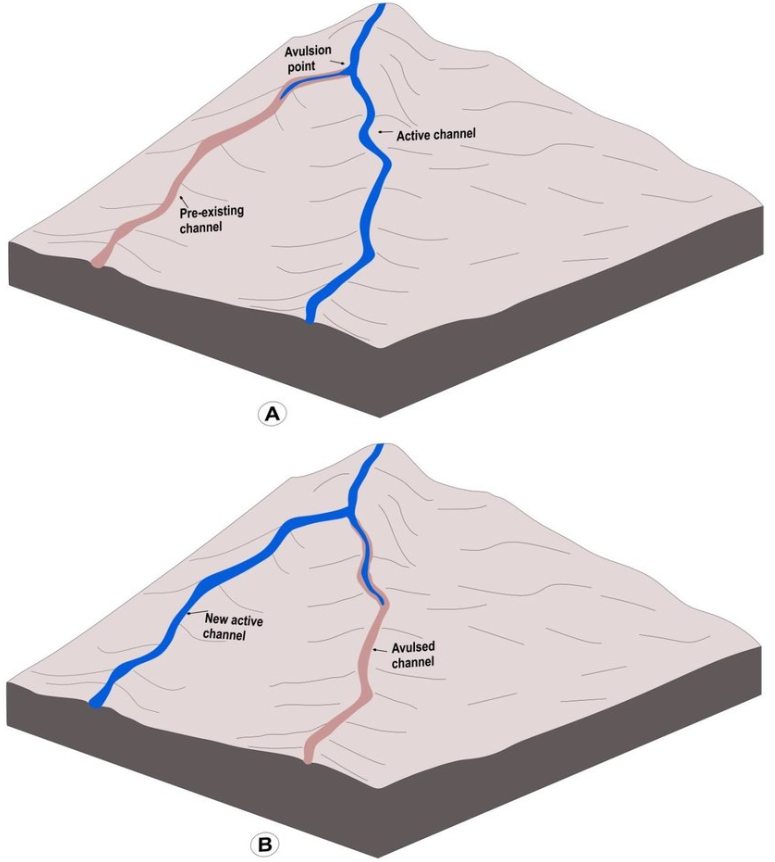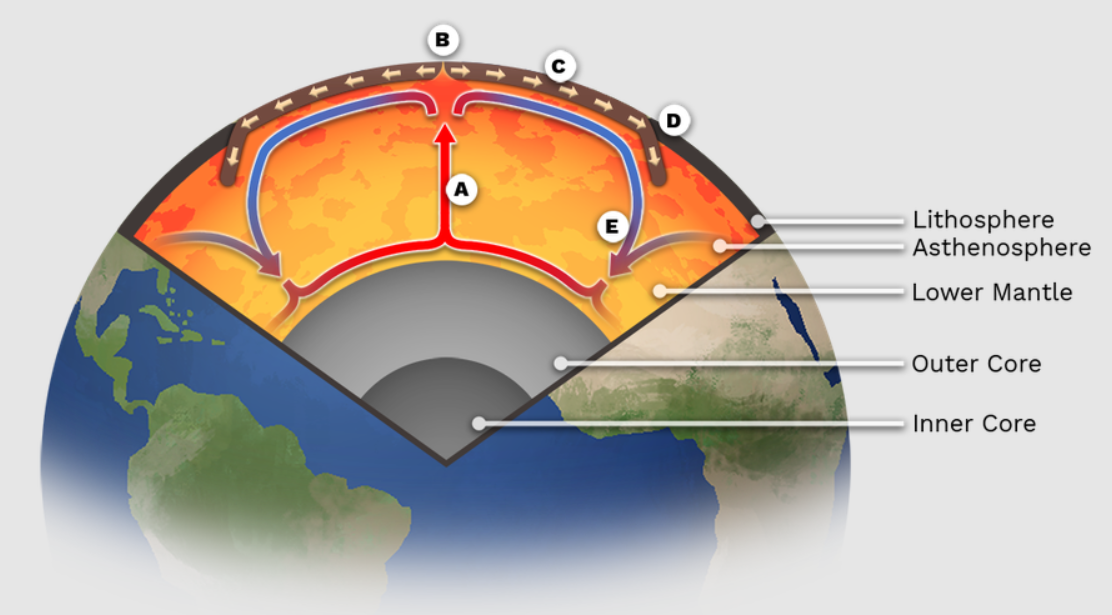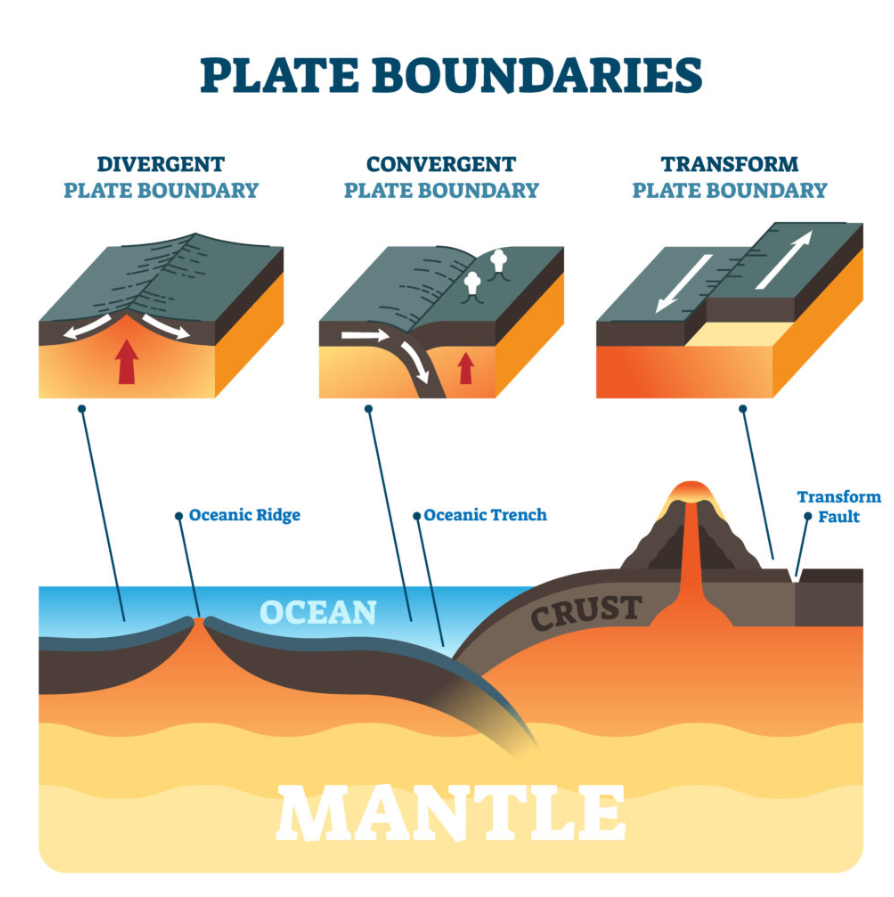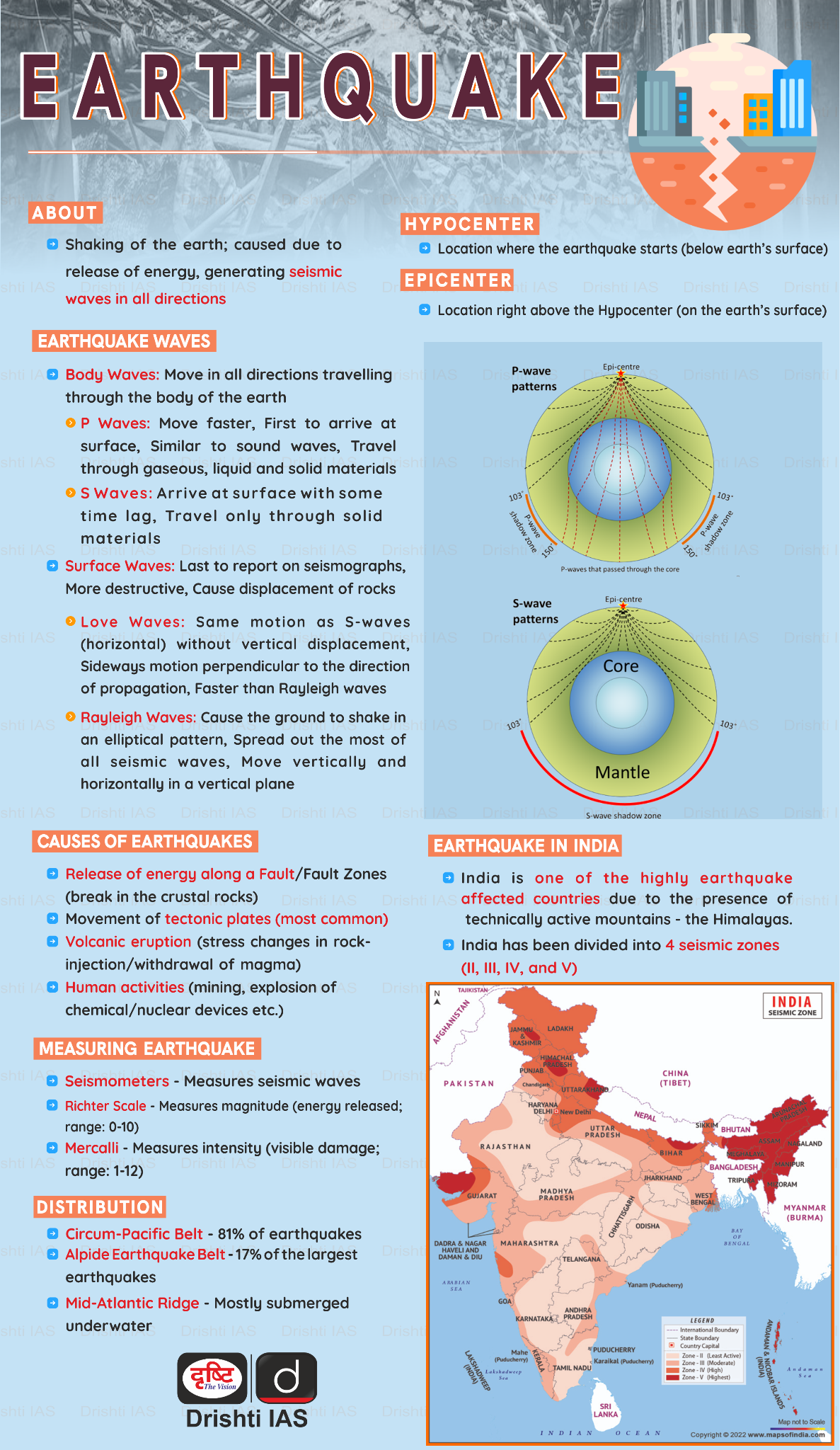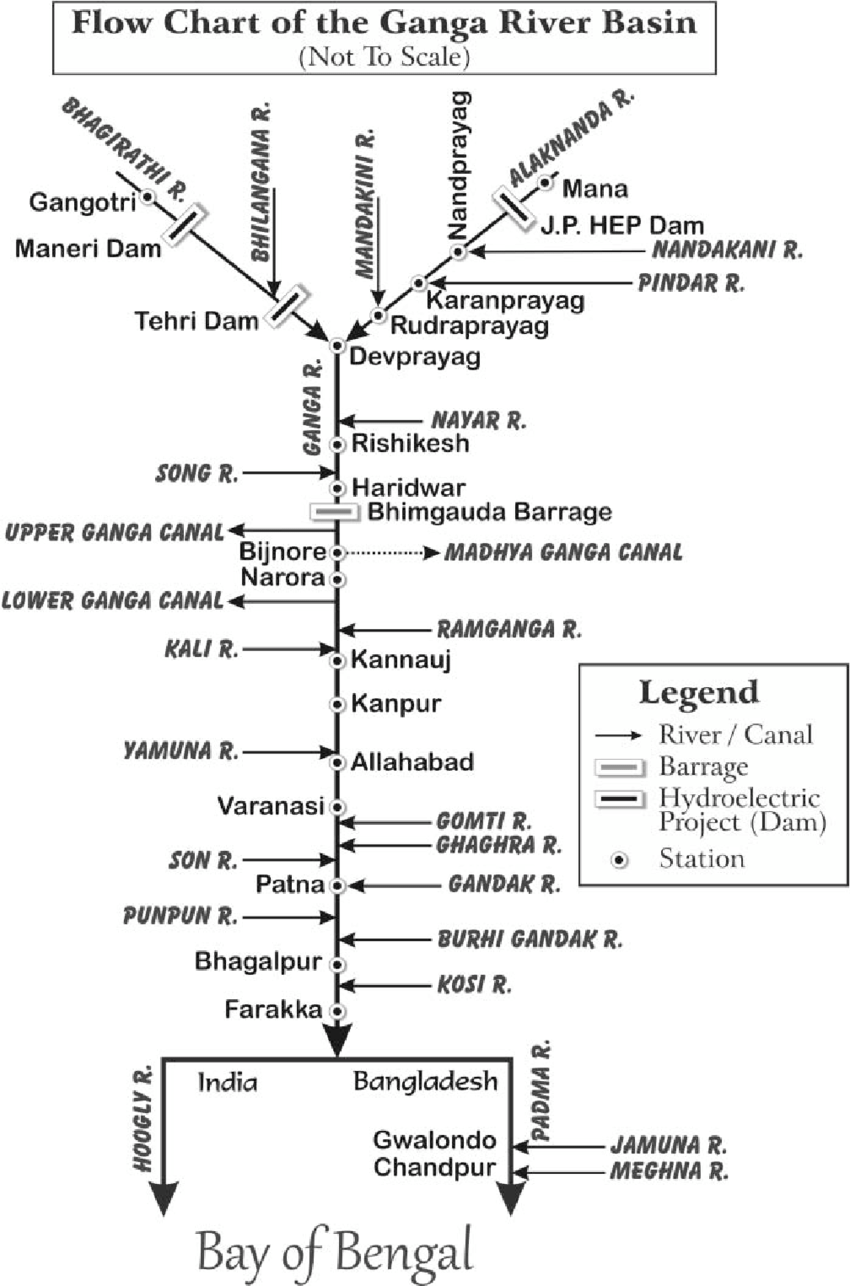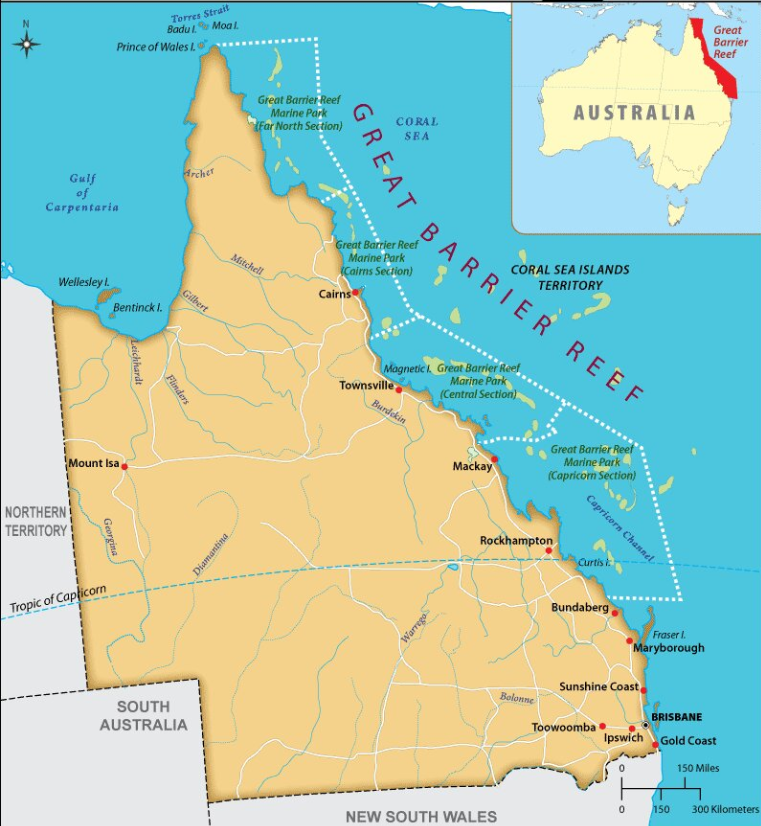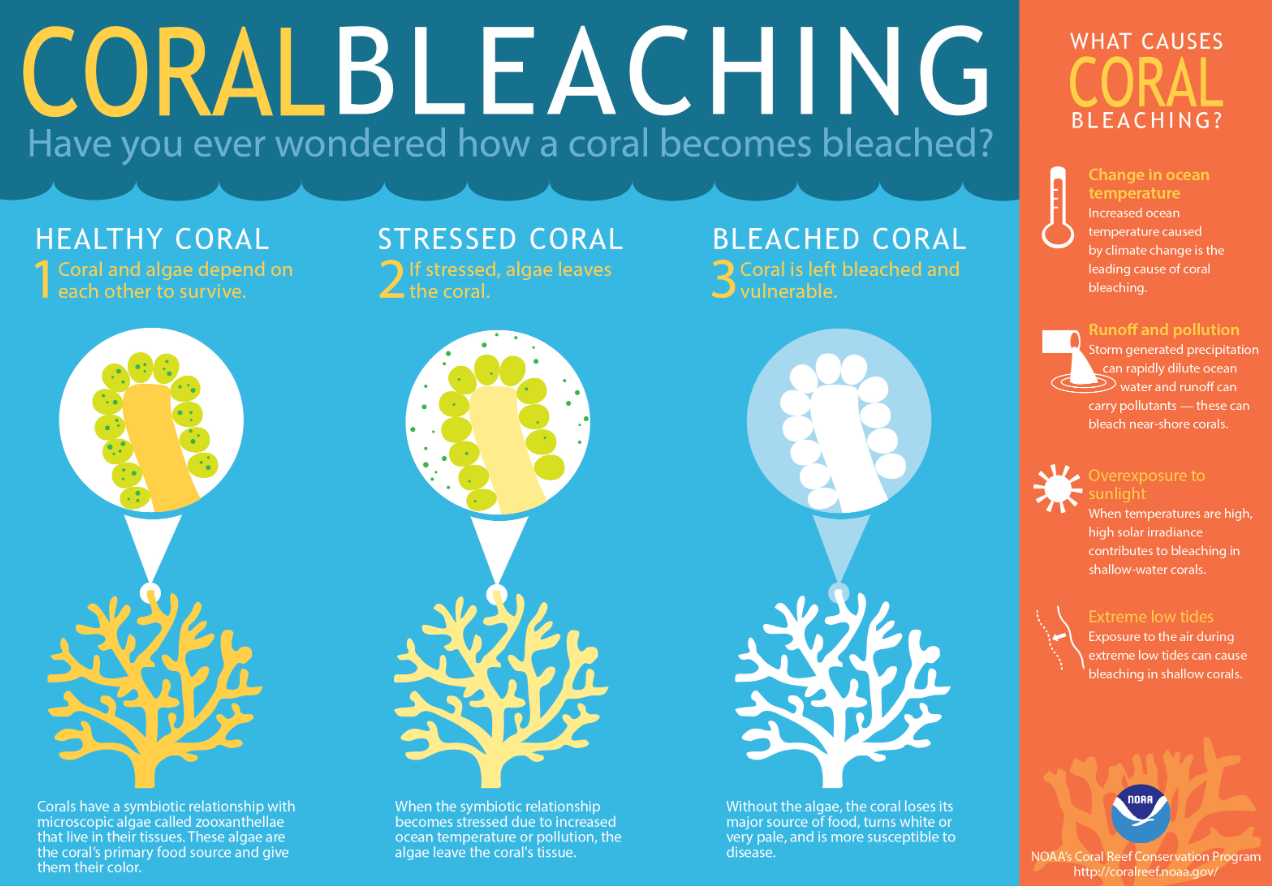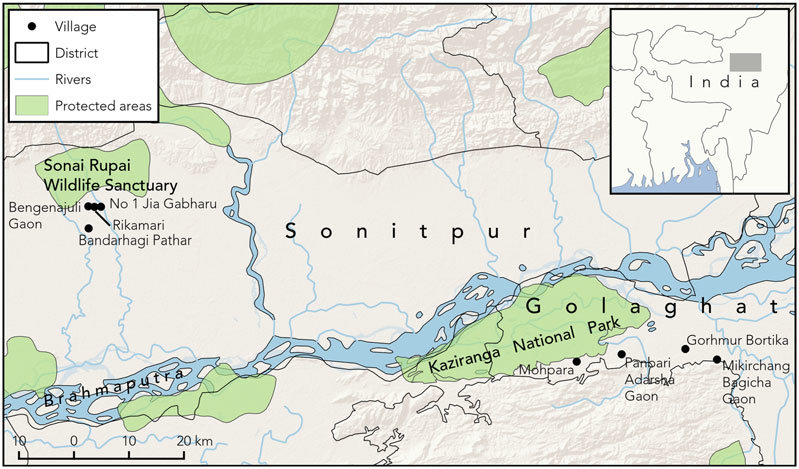Biodiversity & Environment
NITI Aayog Report on Seaweed Value Chain Development
For Prelims: Seaweed, NITI Aayog, Red algae, Blue algae, Major Seaweed Beds in India, CommercialisedSeaweed Products in India.
For Mains: Distribution and Significance of Seaweeds, Seaweed Cultivation in India.
Why in News?
Recently, NITI Aayog has laid down a comprehensive roadmap to promote seaweed cultivation in India in its report published titled “Strategy for the development of Seaweed Value Chain”.
- This includes steps for research, investment, training, infrastructure development, and market promotion to increase seaweed production, which can benefit the environment, economy, and local communities.
What are Seaweeds?
- About Seaweeds:
- They are the primitive, marine non-flowering algae without root, stem and leaves and play a major role inmarine ecosystems.
- Large seaweeds form dense underwater forests known as kelp forests, which act as underwater nurseriesfor fish, snails and sea urchins.
- Some species of seaweeds are Gelidiella acerosa, Gracilaria edulis, Gracilaria crassa, Gracilaria verrucosa,Sargassum spp. and Turbinaria spp.
- It is classified into green (Chlorophyta), brown (Phaeophyta), and red (Rhodophyta) groups.
- Production Scenario:
- Global:
- Global Seaweed production (cultivation+collection) amounted to around 35.8 million tonnes in 2019, of which wild collection remained at 1.1 million tonnes.
- Eastern and Southeastern Asia regions dominated the cultivation landscape with 97.4% of globalproduction, while Americas and Europe primarily depend on wild collection. Indonesia is a major producer of seaweed.
- Globally, the species Kappaphycus alvarezii and Eucheuma denticulatum account for 27.8% of totalseaweed production through farming.
- The seaweed industry is projected to grow at a CAGR of 2.3% from 2022 to 2030.
- India:
- India harvests approximately 33,345 tonnes (wet weight) of seaweeds annually from natural beds,primarily in Tamil Nadu, involving 5,000 families.
- India’s annual seaweed revenue, around Rs 200 crores, contributes less than 1% of global production.
- The government aims to increase the allied sector’s share of gross value added in agriculture to 9% in 2024-25 from 7.28% in 2018-19.
- India harvests approximately 33,345 tonnes (wet weight) of seaweeds annually from natural beds,primarily in Tamil Nadu, involving 5,000 families.
- Global:
- Import and Export:
- In 2021, the global seaweed market stood at USD 9.9 billion.
- Major trading countries included China, Indonesia, the Philippines, the Republic of Korea, and Malaysia.
- Korea leads in seaweed exports with over 30% market share, while China holds a similar share in seaweed- based hydrocolloids (thickening and gelling agents derived from various types of seaweed).
- Major Seaweed Beds in India:
- Abundant seaweed resources are found along the Tamil Nadu and Gujarat coasts, as well as around Lakshadweep and the Andaman & Nicobar Islands.
- Notable seaweed beds exist around Mumbai, Ratnagiri, Goa, Karwar, Varkala, Vizhinjam, and Pulicat in Tamil Nadu, Andhra Pradesh, and Chilka in Orissa.
- Related Government Initiatives:
- Seaweed Mission: This initiative, launched in 2021, aims to commercialise seaweed farming and processing for value addition. It also aims to increase cultivation along India's 7,500-kilometre coastline.
- Pradhan Mantri Matsya Sampada Yojana (PMMSY): The government is also promoting seaweed cultivationin the country through this initiative.
- Commercialisation of Seaweed Products: The Indian Council of Agricultural Research (ICAR)- Central Marine Fisheries Research Institute (CMFRI) has successfully commercialised two seaweed-based nutraceutical products, CadalminTM Immunalgin extract (CadalminTM IMe) and CadalminTM Antihypercholesterolemic extract (CadalminTM ACe).
- These products, developed with eco-friendly 'green' technology, aim to boost anti-viral immunity and combat high cholesterol or dyslipidemia (imbalance of cholesterol).
- Multi-Purpose Seaweed Park in Tamil Nadu.
What are the Uses and Benefits of Seaweeds?
- For Nutrition: Seaweed is a source of calcium, phosphorus, sodium, and potassium, along with vitamins A,B1, B12, C, D, E, niacin, folic acid, pantothenic acid, and riboflavin. They also contain essential amino acids crucial for metabolism and overall health.
- Medicinal Purposes: Seaweeds contain anti-inflammatory and antimicrobial agents, with medicinal effects. Certain seaweeds have cancer-fighting properties, potentially effective against malignant tumours and leukaemia.
- Manufacturing Uses: They are used as binding agents (emulsifiers) in products like toothpaste and fruit jelly and as softeners (emollients) in organic cosmetics and skincare products.
- Commercial Value: Commercially, seaweeds are valued for bioactive metabolites, manure, fodder, and cell wall polysaccharides like agar, algin, and carrageenan.
- They are used in the food, pharmaceutical, cosmetic, and mining industries and as raw materials for extracting marine chemicals.
- Agricultural Benefits: It also serves as crop biostimulants to enhance agricultural productivity, and animal feed additives.
- Seaweed cultivation enhances marine production, boosts fish farmers' incomes, and diversifies coastal livelihoods. Under optimal conditions, one hectare (400 bamboo rafts) can generate up to Rs 13,28,000 per year, with a family of two managing 45 rafts, creating valuable income opportunities.
- Bioindicator: Seaweeds absorb excess nutrients from agricultural, industrial, aquaculture, and household waste, preventing algal blooms and balancing the marine ecosystem.
- Environmental Benefits: Seaweeds help reduce carbon footprints. Mariculture seaweed’s estimated carbon sequestration rates amount to 57.64 metric tonnes of CO2 per hectare per year, while pond-cultured seaweeds sequester 12.38 metric tonnes of CO2 per hectare.
What are the NITI Aayog’s Recommendations for Promoting Seaweed Production in India?
- Amendment in the Allocation of Business Rules, 1961: Currently, seaweed is classified as "fish" under theMaritime Zones of India Act, 1981, and its global production is tracked by the FAO. Assign seaweed valuechain development to the Department of Fisheries for better management.
- Exports and Certification of Seaweed and its Products: Transfer seaweed exports and certification oversight to MPEDA under the Ministry of Commerce & Industry, with National Cooperative Development Corporation (NCDC) handling sales through FPOs and SHGs.
- Implement international certification harmonisation, with MPEDA establishing protocols and an independent body managing certification.
- Priority Sector Lending: The RBI should consider adding seaweed-related credit to the list of priority sector lending (PSL) for banks, given its role in addressing climate change.
- Comprehensive risk Cover through Insurance: To address risks from weather events in seaweed farming, a comprehensive insurance scheme should be developed. This scheme should include crop insurance, life insurance for farmers, and coverage for capital infrastructure.
- Financial Support: The PM-KISAN and PMFBY schemes should be expanded to include seaweed farmers, with the Ministry of Agriculture & Farmers Welfare (MoA&FW) formulating the necessary guidelines for financial and input support
- Also incorporating them into the Kisan Credit Card (KCC) scheme and promoting joint liability groups (JLGs) to facilitate group financing should be promoted.
- Investment and Ease of Doing Business:
- Increase investments in coastal seaweed sectors by encouraging both public and private investments, leveraging reforms and initiatives like Stand-up India and Startup India.
- Develop a dynamic data portal with geo-tagged sites for seaweed cultivation to support cluster development and access for various stakeholders.
- Include seaweed and its products in e-NAM and state agriculture mandis, and explore PPPs for sales interventions.
- Scale up the Seaweed Farmer Service Platform (SFSP) for data-based decision-making.
- Establish seed banks across maritime states and UTs for immediate availability of quality seed material after monsoon.
- Create Logistics and Processing Centers at cluster levels for primary processing, including warehouses, transport, and packaging facilities.
- Increase investments in coastal seaweed sectors by encouraging both public and private investments, leveraging reforms and initiatives like Stand-up India and Startup India.
- Skill Development: Offer certificate and diploma courses on seaweed cultivation, harvesting, and post- harvest management through agriculture and fisheries universities, MPEDA-RGCA, and ICAR institutes.
|
Drishti Mains Question: What are Seaweeds and its uses? What are the government initiatives to promote its cultivation in India? |
Geography
Underwater Structures in the Indian Ocean
For Prelims: Deep Sea Oceans, Relief, Structures and Types, Mauryan Empire.
For Mains: Different Underwater Structures/Relief on the Ocean Floor
Why in News?
Recently, three underwater structures in the Indian Ocean were named as Ashoka, Chandragupt, and Kalpataru, which reflect India's growing influence in marine science and its commitment to exploring and understanding the Indian Ocean.
- This naming was proposed by India and approved by the International Hydrographic Organisation (IHO) and UNESCO’s Intergovernmental Oceanographic Commission (IOC).
International Hydrographic Organisation (IHO)
- It is an intergovernmental consultative and technical body established in 1921 to enhance navigation safety and protect the marine environment.
- India is a member of the IHO.
- Objectives:
- Coordinating the activities of national hydrographic offices.
- Achieving the highest possible uniformity in nautical charts and documents.
- Promoting the adoption of reliable and efficient methods for conducting and utilising hydrographic surveys.
- Advancing the sciences of hydrography and the techniques used in descriptive oceanography.
UNESCO’s Intergovernmental Oceanographic Commission (IOC)
- It promotes international cooperation in marine sciences, capacity development, ocean observations and services, ocean science, tsunami warning, and ocean literacy.
- It has 150 member states, and India has been a member since 1946.
- The IOC's work contributes to UNESCO's mission to promote the advancement of science and its applications for economic and social progress.
- The IOC is coordinating the United Nations Decade of Ocean Science for Sustainable Development 2021-2030, also known as the "Ocean Decade."
What are the Key Facts About the Underwater Structures?
- Background and Significance: The discoveries of these underwater structures are part of the Indian Southern Ocean Research Programme, initiated in 2004, with the National Centre for Polar and Ocean Research (NCPOR) as the nodal agency.
- The program aims to study various aspects including bio-geochemistry, biodiversity, and hydrodynamics.
- Total Structures:
- Seven structures, including the recently added ones in the Indian Ocean, are now named primarily after Indian scientists or based on names proposed by India.
- Previously Named Structures:
- Raman Ridge (accepted in 1992): It was discovered in 1951 by a US oil vessel. It was named after Physicist and Nobel Laureate Sir CV Raman.
- Panikkar Seamount (accepted in 1993): It was discovered in 1992 by India research vessel Sagar Kanya. It is named after NK Panikkar, a renowned oceanographer.
- Sagar Kanya Seamount (accepted in 1991): For its successful 22nd cruise in 1986 leading to its discovery, a seamount was named after the research vessel Sagar Kanya itself.
- DN Wadia Guyot: It was named after geologist DN Wadia in 1993 when an underwater volcanic mountain (guyot), was discovered in 1992 by Sagar Kanya.
- Recently Named Structures:
- Ashoka Seamount: It was discovered in 2012. It is in an oval-shaped structure spanning approximately 180 sq km and was identified using the Russian vessel Akademik Nikolay Strakhov.
- Kalpataru Ridge: It was discovered in 2012. This elongated ridge covers an area of 430 sq km and may play a critical role in supporting marine biodiversity.
- Experts believe that this ridge could have provided essential support for marine life by offering habitat shelter and food sources for various species.
- Chandragupt Ridge: This ridge is an elongated structure covering 675 sq km. It was identified in 2020 by the Indian research vessel MGS Sagar.
Who were Ashoka and Chandragupta?
- Chandragupta Maurya (350–295 BCE):
- He was the Emperor of Magadha and the founder of the Maurya dynasty, which established a significant empire centred in Magadha.
- He took advantage of the decline and weakness of the Nandas and overthrew the last ruler of the Nanda dynasty, Dhanananda with the help of Chanakya (Kautilya) and crowned himself as the emperor.
- He gave up his throne and became a disciple of Jain teacher Bhadrabahu.
- Ashoka: He was the third king (after Chandragupta Maurya and Bindusara) of the Mauryan dynasty and ruled around 269 BC.
- Ashoka's policy of Dhamma and efforts to spread Buddhism are significant aspects of his rule.
- He adopted the titles of Priyadasi and Devanampiya, which can be seen in his Rock and Pillar edicts.
Note:
- "Kalpataru" is a Sanskrit term that translates to "wish-fulfilling tree." In Hindu mythology, it is often associated with a divine tree that grants wishes and desires to those who seek its blessings. The concept symbolises abundance, prosperity, and the fulfillment of dreams.
What are the Different Underwater Structures/Relief on the Ocean Floor?
- About:
- Ocean Floor or Seabed is the bottom of the water that covers more than 70% of the Earth’s surface and it includes elements like Phosphorus, Gold, Silver, Copper, Zinc, and Nickel.
- The primary causes of Ocean Relief are interactions between tectonic plates, and erosional, depositional, and volcanic processes.
- Ocean Floor or Seabed is the bottom of the water that covers more than 70% of the Earth’s surface and it includes elements like Phosphorus, Gold, Silver, Copper, Zinc, and Nickel.
- Zones of Ocean Floor:
- Continental Shelf:
- The shallowest and widest part of the ocean floor.
- Extends from the coast to the edge of the continent, where it drops sharply into the continental slope.
- Rich in marine life and resources, such as fish, oil, and gas.
- Continental Slope:
- The steep slope that connects the continental shelf to the abyssal plain
- Cut by deep canyons and valleys that are formed by underwater landslides and rivers of sediment.
- Home to some deep-sea creatures, such as octopuses, squids, and anglerfish.
- Continental Rise:
- Made up of thick sequences of continental material that accumulate between the continental slope and the abyssal plain.
- It can rise from processes such as the downhill movement of sediment, the settling of particles carried by underwater currents, and the slow settling of both non-living and living particles from above.
- Abyssal Plain:
- The flattest part of the ocean floor.
- Covers most of the ocean basin and lies between 4,000 and 6,000 meters below sea level.
- Covered by a thick layer of fine sediments that are carried by ocean currents and settle on the seafloor.
- Inhabited by some of the most bizarre and mysterious animals on Earth, such as giant tube worms, bioluminescent fish, and vampire squids.
- Continental Shelf:
- Oceanic Deeps or Trenches:
- These areas are the deepest parts of the oceans.
- The trenches are relatively steep sided, narrow basins. They are some 3-5 km deeper than the surrounding ocean floor.
- They occur at the bases of continental slopes and along island arcs and are associated with active volcanoes and strong earthquakes, so are very significant in the study of plate movements.
- Minor Relief Features of Ocean Floor:
- Submarine Canyons: They are significant geological structures found on continental margins, serving as connections between the upper continental shelf and the abyssal plain.
- They are deep, narrow valleys featuring vertical sidewalls and steep slopes, similar to land valleys.
- Mid Oceanic Ridges: They are found along diverging plate boundaries where tectonic plates move apart, and the gap is filled by upwelling magma that solidifies to form new oceanic crust.
- These ridges consist of two parallel mountain ranges separated by a deep depression. The mountain peaks can reach heights of up to 2,500 meters.
- Seamounts and Guyots: Seamounts are undersea mountains formed by volcanic activity that risehundreds or thousands of feet from the sea floor, often near plate boundaries. Example the Emperor seamount, an extension of the Hawaiian Islands in Pacific Ocean
- Guyots are flat-topped seamounts that have been submerged as the seafloor gradually sinks away from oceanic ridges.
- Atoll: It is a ring-shaped formation of coral reefs or islands that encircles a lagoon, typically developing seamounts.
- These structures consist of low islands in tropical oceans, with the reef surrounding a central depression that can contain various types of water, including seawater, fresh water, or brackish water.
- Submarine Canyons: They are significant geological structures found on continental margins, serving as connections between the upper continental shelf and the abyssal plain.
| Drishti Mains Question: Q. What are the different types of oceanic relief features found on the ocean floor? |
Indian Economy
Decline in Work Demand Under MGNREGS
For Prelims: Mahatma Gandhi National Rural Employment Guarantee Scheme (MGNREGS), International Monetary Fund (IMF), Monsoon, Migration, Work Guarantee Programmes, Employment, Unemployment Allowance, Gram Sabha, Social Audit, Below Poverty Line, Panchayati Raj Institution (PRI)
For Mains: Role of Mahatma Gandhi National Rural Employment Guarantee Scheme (MGNREGS).
Why in News?
According to the Ministry of Rural Development, work demand under the Mahatma Gandhi National Rural Employment Guarantee Scheme (MGNREGS) fell sharply in July 2024.
What Does a Decline in Demand for Work under the MGNREGS Indicate?
- Current State of Demand for Work: Approximately 22.80 million individuals sought work under the scheme in July, reflecting a 21.6% decline from the same period in 2023.
- These individuals represented 18.90 million households, a decrease of 19.5% year-over-year and 28.4% compared to June 2024.
- On a month-to-month basis, the number of people seeking work dropped by 33.4% in July 2024.
- In July 2024, fewer individuals submitted work demands in key states like Tamil Nadu, Andhra Pradesh, Karnataka and Telangana .
- Reasons For Decline in Demand Work:
- Strong Economic Activity:
- Work demand under MGNREGS usually drops when better-paying employment opportunities are available due to strong economic growth, possibly reflecting robust economic activity.
- The economy grew at a higher-than- anticipated pace of 8.2% in the last Fiscal Year (FY) 2023-24.
- The International Monetary Fund (IMF) predicts India will be the fastest- growing major economy, with growth rates of 7% in FY 2024-25 and 6.5% in 2025-26, both exceeding the global average.
- Impact of Monsoon:
- Strong Economic Activity:
What is Mahatma Gandhi National Rural Employment Guarantee Scheme (MGNREGS)?
- About:
- MGNREGS is one of the largest work guarantee programmes in the world launched in 2005 by the Ministry of Rural Development.
- It guarantees 100 days of employment each financial year for adult members of rural households willing to perform unskilled manual work at the statutory minimum wage.
- Implementation Agency:
- The Ministry of Rural Development monitors the entire implementation of this scheme in association with state governments.
- Major Features:
- The cornerstone of MGNREGA's design is its legal guarantee, ensuring that any rural adult can request work and must receive it within 15 days.
- If this commitment is not met, an "unemployment allowance" must be provided.
It requires that priority shall be given to women in such a way that at least one-third of the beneficiaries shall be women who have registered and requested for work.
- If this commitment is not met, an "unemployment allowance" must be provided.
- Section 17 of the Mahatma Gandhi NREGA, 2005 mandates the Gram Sabha to conduct social audits of works undertaken under the scheme.
- The cornerstone of MGNREGA's design is its legal guarantee, ensuring that any rural adult can request work and must receive it within 15 days.
- Objective:
- It was introduced with an aim of improving the purchasing power of the rural people, primarily semi or unskilled work to people living below poverty line in rural India.
- It attempts to bridge the gap between the rich and poor in the country.
- Current Status:
- Budget Allocation: For the financial year 2023-24, the government allocated approximately Rs 73,000 crore to MGNREGA, reflecting an increase from previous years to meet the rising demand for employment.
- Employment Generation: In the FY 2022-23, MGNREGA provided over 300 crore person-days of work, with approximately 11 crore households participating in the scheme.
- Wage Payments: The Centre has notified a 3-10% increase in the wage rates for MGNREGA workers for the FY 2024-25.
- The average wage for 2024-25 is Rs 289 as against Rs 261 for FY 2023-24.
- Project Focus: The scheme has increasingly focused on sustainable development projects, such as water conservation, afforestation, and rural infrastructure enhancement. Over 60% of the works undertaken are related to natural resource management.
What are the Challenges with the Implementation of the MGNREGS?
- Concerns Over Minimum Wage Determination: A panel from the Ministry of Rural Development has raised concerns that the minimum wage under MGNREGS is based on the Consumer Price Index for Agricultural Labourers,which does not reflect the different types of work performed by MGNREGS workers.
- They recommend using the Consumer Price Index-Rural instead, as it is more current and accounts for higher expenses on education and healthcare.
- Poor Planning & Administrative Skill: Panchayats, except in some states likeKarnataka and West Bengal, lack experience in planning large-scale programs.The Comptroller and Auditor General (CAG) highlighted inadequateadministrative capacity among village panchayat members.
- Lack of Adequate Manpower: Insufficient administrative and technical staff atBlock and Grama Panchayat levels affects planning, monitoring, andtransparency.
Difficulty in Funding the Scheme: The budget for MGNREGS has increased significantly, raising concerns about sustainability and funding sources.- The declining tax-GDP ratio poses challenges for financing the program.
- Discrimination: While MGNREGA promotes equal pay, instances ofdiscrimination against women and marginalised groups persist. Some statesshow high enrollment of women, while others exhibit low participation due tosystemic biases.
- Corruption & Irregularities: High levels of corruption result in minimal fundsreaching intended beneficiaries. Issues like fake job cards for non-existent workers lead to significant financial losses.
Way Forward
- Increase of Entitled Work Days: While a full 100 days of employment has notbeen provided per year, the Parliament Committee and activist groups havestrongly recommended an increase in the number of guaranteed days of workper household from 100 to 150 so that rural populations have a safety net fora longer period in the year.
- Capacity Building: Provide training programs for panchayat members toimprove planning and implementation skills and establish clear guidelines andbest practices for effective program management.
- Monitoring: Implement robust monitoring mechanisms to track fund allocationand project outcomes.Use technology, such as mobile apps and online portals,to enhance transparency and accountability.
- Updated Wage Determination: Shift the minimum wage determination to the Consumer Price Index-Rural to better reflect the living costs faced by MGNREGS workers.
- Regularly update wage rates to keep pace with inflation and local economic conditions.
|
Drishti Mains Question: Q. Discuss the role of the Mahatma Gandhi National Rural Employment Guarantee Scheme (MGNREGS) in generating employment in rural areas. What challenges are associated with the scheme? |
UPSC Civil Services Examination, Previous Year Questions (PYQs)
Prelims
Q. Among the following who are eligible to benefit from the “Mahatma Gandhi National Rural Employment Guarantee Act”? (2011)
(a) Adult members of only the scheduled caste and scheduled tribe households
(b) Adult members of below poverty line (BPL) households
(c) Adult members of households of all backward communities
(d) Adult members of any household
Ans: (d)
Mains
Q. Hunger and Poverty are the biggest challenges for good governance in India still today. Evaluate how far successive governments have progressed in dealing with these humongous problems. Suggest measures for improvement. (2017)
Q. Do government’s schemes for up-lifting vulnerable and backward communities by protecting required social resources for them, lead to their exclusion in establishing businesses in urban economies? (2014)
Geography
Tectonic Events Changed the Course of Ganga
For Prelims: Ganges Delta, Paleochannel, Indo-Burma Mountain Ranges, Tectonic Plates, Ganges-Meghna-Brahmaputra Delta, Seismic Waves, Sand Dikes, Liquefaction, Optically Stimulated Luminescence (OSL) Dating, Flood, Subsidence
For Mains: Role of Important Geophysical Phenomena in shaping the of Earth.
Recently, Researchers studied river channels in the Ganges delta in Bangladesh.
- They discovered a paleochannel (ancient river channel) indicating the Ganga had changed its course abruptly about 2,500 years ago due to an earthquake.
How Earthquakes Impact the Course of a River Ganga?
- Earthquake Origin: The researchers speculated the earthquake could have originated from the Indo-Burma mountain ranges or the Shillong hills, where the Indian and Eurasian tectonic plates meet.
- Impact: The discovery highlights that large earthquakes can trigger major river avulsions (changes in the course of river flow), which could lead to devastating floods, especially in densely populated regions like the Ganges-Meghna- Brahmaputra delta.
- Earthquake Evidence:
- Seismite Formation: Seismites (sedimentary beds deformed by seismic movements) are formed when seismic waves pressurise a layer of watery sand, causing it to burst through mud layers.
- Sand Dikes: Researchers found two large sand dikes a kilometre to the east of the palaeochannel. Sand Dikes are formed when earthquakes disturb the river bed and cause sediments to flow (liquefaction).
- Dating Techniques: Researchers used optically stimulated luminescence (OSL) dating to estimate the timing of the avulsion and the formation of the sand dikes. They determined that both events occurred around 2,500 years ago, suggesting the earthquake caused the river avulsion.
- Future Hazards and Recommendations:
- Potential Impact: A similar earthquake today could flood areas affecting up to 170 million people in India and Bangladesh.
- Increased Risk: Factors such as rapid subsidence and climate change-induced sea level rise increase the risk of river avulsions.
- Future Research: Emphasis should be placed on understanding the frequency of quake-driven avulsions and improving earthquake forecasting.
- Preparedness: There is a need for collaboration between India, Bangladesh, and Myanmar for research, monitoring, and preparedness to mitigate the risks associated with such natural disasters.
What are Tectonic Activities?
- Tectonic Activities:
- The Earth's outermost layer, the lithosphere (comprising the crust and upper mantle), is broken into large rocky plates.
- These plates rest on a partially molten layer called the asthenosphere.
- Due to convection current in the asthenosphere, the plates move at different rates, from 2-15 centimetres per year.
- This movement creates various geological formations, including the Himalayas, the East African Rift and the San Andreas Fault in California.
- It explains how major landforms including the formation of mountains, volcanic activity, and earthquakes are created by the movements beneath the Earth's surface.
- The seven major plates listed from largest to smallest are the Pacific, NorthAmerican, Eurasian, African, Antarctic, Indo-Australian and the South American Plate.
- The Earth's outermost layer, the lithosphere (comprising the crust and upper mantle), is broken into large rocky plates.
- Earthquakes due to Tectonic Activities:
- Tectonic activities lead to earthquakes primarily through the movement of the Earth's tectonic plates.
- Earthquakes typically occur at the boundaries of tectonic plates, which can be categorised into three main types:
- Convergent Boundaries: Plates move toward each other, causing one plate to be forced beneath another (subduction). This process can create intense pressure and lead to powerful earthquakes.
- Divergent Boundaries: Plates move apart from each other, allowing magma to rise and create new crust. Earthquakes here are usually less powerful but frequent.
- Transform Boundaries: Plates slide past each other horizontally. The friction between the plates can cause stress to build up, which, when released, results in an earthquake.
What are Key Facts About the Ganga River System?
- The Ganga originates as Bhagirathi from Gangotri Glacier, Uttarakhand at an elevation of 3,892 m.
- Many small streams comprise the headwaters of the Ganga. The important among these are Alaknanda, Dhauliganga, Pindar, Mandakini and Bhilangana.
- At Devprayag, where Alaknanda joins Bhagirathi, the river acquires the name Ganga. It traverses 2525 km before flowing into the Bay of Bengal.
- The Ganga is formed from the 6 headstreams and their five confluences.
- Devprayag: Confluence of Bhagirathi river and Alaknanda river.
- Rudraprayag: Confluence of Mandakini river and Alaknanda river.
- Nandaprayag: Confluence of Nandakini river and Alaknanda river.
- Karnaprayag: Confluence of Pindar river and Alaknanda river.
- Vishnuprayag: Confluence of Dhauliganga river and Alaknanda river.
- The Bhagirathi, considered to be the source stream, rises at the foot of Gangotri Glacier, at Gaumukh. It finally empties into the Bay of Bengal.
- Major Tributaries of the Ganga River:
- Left Bank Tributaries: Ramganga, Gomti, Ghaghara, Gandak, Burhi Gandak, Koshi, Mahananda.
- Right Bank Tributaries: Yamuna, Tons, Karamnasa, Sone, Punpun, Falgu, Kiul, Chandan, Ajoy, Damodar, Rupnarayan.
- The Ganga flows out of the hills and into the plains at a point where it meets the Yamuna in Allahabad.
- Delta and Outflow:
- After a journey of around 2,510 kilometres, the Ganga River merges with the Brahmaputra River in Bangladesh, forming the Padma River.
- The Padma River then joins the Meghna River and flows into the Bay of Bengal through the Meghna Estuary.
- After a journey of around 2,510 kilometres, the Ganga River merges with the Brahmaputra River in Bangladesh, forming the Padma River.
Tectonic Movement and Decline of Harappan Civilization
- Multiple layers of silt at Mohenjodaro show that repeated Indus river floods contributed to the decline of the Harappan civilization.
- Researchers argued that the floods at Mohenjodaro were the result of tectonic movements.
- The theory states that the Indus area is a disturbed seismic zone and tectonic movements led to the creation of a gigantic natural dam that prevented the Indus from flowing towards the sea, turning the area around Mohenjo Daro into a huge lake.
- It caused prolonged submergence of the cities located on the bank of the river Indus.
- They argued that such flooding which could drown buildings 30 feet above the ground level of the settlement could not be the result of normal flooding in the river Indus.
- However, few researchers pointed out that the idea that a river would be dammed in such a manner even by tectonic uplifts is not convincing.
|
Drishti Mains Question: Q. What is Plate Tectonics? How does it affect the various geophysical phenomena on Earth? |
UPSC Civil Services Examination Previous Years’ Questions (PYQs)
Mains
Q. Mention the global occurrence of volcanic eruptions in 2021 and their impact on the regional environment. (2021)
Q. Briefly mention the alignment of major mountain ranges of the world and explain their impact on local weather conditions, with examples. (2021)
Q. Explain the formation of thousands of islands in Indonesian and Philippines archipelagos. (2014)
Facts for UPSC Mains
Rising Costs for Senior Citizens Under Ayushman Bharat
Why in News?
Recently, the Union Ministry of Health and Family Welfare released data highlighting significant trends in the Ayushman Bharat Health Insurance Scheme (PM-JAY). This information underscores the increasing financial burden of providing healthcare to the elderly, particularly those aged 70 years and above.
What are the Key Takeaways Regarding Ayushman Bharat?
- Significant Elderly Admissions: The data reveals that out of nearly 6.2 crore approved hospital admissions until January 2024, 57.5 lakh were senior citizens aged 70 years and above. Government expenditure on treatments under the scheme totaled Rs 79,200 crore over the past six years, with approximately Rs 9,900(14%) crore allocated specifically for treating individuals aged 70 and over.
- Elderly patients often require more intensive and costly treatments due to chronic conditions and multiple comorbidities, complicates treatment, increasing the likelihood of costly intensive care unit (ICU) care and extended hospital stays.
- State Variability: The proportion of elderly admissions varied widely among states, with Maharashtra (20.49%) and Kerala (18.75%) having the highest rates, while Tamil Nadu (3.12%) had the lowest.
- Despite lower admission rates in Tamil Nadu, the cost of treatment per elderly patient remains high.
- Only four states/UT — Goa, Ladakh, Lakshadweep, and Jharkhand showed a higher proportion of hospital admissions for older individuals compared to the total money spent on them.
- Concerns:
- According to the Longitudinal Ageing Study in India (LASI), India's population over the age of 60 years is estimated to increase from 8.6% in 2011 to 19.5% by 2050, with the absolute number tripling from 103 million in 2011 to 319 million in 2050.
- The government's plan to expand Ayushman Bharat aims to include all individuals over 70 years, regardless of economic status. This expansion could add nearly 4 crore new beneficiaries to the programme.
- The current allocation of Rs 7,300 crore for the scheme, with only a Rs 100 crore increase from the previous budget, raises concerns about the adequacy of funding for such an expansion.
- As healthcare costs for the elderly continue to rise, the scheme's sustainability and its ability to provide comprehensive coverage to all senior citizens will be a critical area of focus for policymakers.
- Health-seeking behaviour is more prevalent among older, relatively affluent individuals, leading to a higher likelihood of policy utilisation and increased costs.
- Experts warn that the cost of covering this demographic is likely to be higher than covering the poorest 40% across all age groups.
What are the Key Highlights About Ayushman Bharat Scheme?
- About: Ayushman Bharat, launched as a flagship scheme of the Government of India, is a significant step towards achieving Universal Health Coverage (UHC). Recommended by the National Health Policy of 2017, this scheme aims to meet the Sustainable Development Goals (SDGs), particularly the commitment to "leave no one behind."
- Key Components: Ayushman Bharat is structured around two interrelated components that work together to provide a seamless flow of care:
- Health and Wellness Centres (HWCs): Announced in 2018, the creation of 1,50,000 HWCs aims to transform existing Sub Centres and Primary Health Centres, delivering Comprehensive Primary Health Care including maternal and child health, non-communicable diseases, and free essential drugs and diagnostic services.
- Pradhan Mantri Jan Arogya Yojana (PM-JAY): It is the world's largest health assurance scheme, providing Rs. 5 lakh coverage per family per year for secondary and tertiary care hospitalisation, targeting over 12 crore poor and vulnerable families, covering approximately 55 crore beneficiaries, based on the Socio-Economic Caste Census 2011 (SECC 2011).
- PM-JAY subsumed the Rashtriya Swasthya Bima Yojana (RSBY) and the Senior Citizen Health Insurance Scheme (SCHIS), expanding its reach and impact.
- Implementation: The Ayushman Bharat National Health Protection Mission Agency (AB-NHPMA) manages the scheme at the national level.
- States and UTs are advised to implement the scheme through a dedicated State Health Agency (SHA), which can operate through an insurance company, a trust/society, or an integrated model.
- Impact: The scheme is expected to significantly reduce Out-of-Pocket Expenditure for healthcare by covering nearly 40% of the population, including secondary and tertiary hospitalizations.
- With coverage up to Rs. 5 lakh per family, the scheme ensures access to quality healthcare, leading to improved health outcomes.
Other Health Related Initiatives for the Elderly in India
Way Forward
- Targeted Interventions: Develop specialised packages addressing common geriatric conditions to optimise resource allocation. Emphasise preventive healthcare and early intervention to reduce the severity of illnesses among the elderly.
- Financial Sustainability: Increased budgetary allocation for Ayushman Bharat, especially for geriatric care. Explore public-private partnerships to share the financial burden.
- Focus on Preventive Healthcare: Implement preventive healthcare measures targeting chronic conditions, ultimately lowering overall healthcare costs.
- Promote community health programs that encourage regular check-ups and early detection of health issues, especially in rural areas where access to healthcare is limited.
|
Drishti Mains Question: Discuss the challenges presented by India's ageing population in the context of the Ayushman Bharat Health Insurance Scheme. |
UPSC Civil Services Examination Previous Years’ Questions (PYQs)
Mains:
Q. “Besides being a moral imperative of a Welfare State, primary health structure is a necessary precondition for sustainable development.” Analyse. (2021)
Important Facts For Prelims
Warming of Great Barrier Reef Waters
Why in News?
Ocean temperatures in the Great Barrier Reef hit their highest level in 400 years over the past decade. The reef suffered mass coral bleaching events between 2016 and 2024.
Great Barrier Reef (GBR)
- The GBR is the world's largest coral reef system. It's located in the Coral Sea off the coast of Queensland, Australia.
- It stretches across 2,300 km and is made up of around 3,000 individual reefs and 900 islands. The GBR is home to 400 types of coral, and 1,500 species of fish.
- It's also home to endangered species such as the dugong and the large green turtle.
- The GBR is a UNESCO World Heritage site and was inscribed in 1981.
- Widespread mass bleaching of the Great Barrier Reef was first seen in 1998 and happened again in 2002, 2016, 2017, 2020, 2022 and 2024.
What are the Research Findings?
- Coral Bleaching: Aerial surveys of more than 300 reefs along Australia's northeast coast revealed bleaching in shallow waters, affecting two-thirds of the reef.
- Rising Threats: Even if global warming is kept under the Paris Agreement's goal, 70% to 90% of corals across the globe could be threatened.
- Less Diversity: Coral reefs have been evolving over the past quarter century in response to bleaching events. As more heat-tolerant coral replaces the less heat-tolerant species, there is a real concern about the expected extreme loss in the number of species and reduction in area that the world's largest reef covers.
What are Coral Reefs?
- About:
- Coral reefs are marine ecosystems primarily composed of coral polyps that form symbiotic relationships with zooxanthellae, a photosynthetic algae.
- The zooxanthellae provide corals with nutrients and oxygen, while corals offer shelter. This mutualism is vital for the health and survival of coral reefecosystems.
- Types:
- Hydrocorals (Fire Corals): They are reef-building hydroids that have a hard calcareous exoskeleton and stinging cells that can cause a burning sensation when touched.
- Octocorals (Soft Corals): It includes sea fans and sea whips, which grow more like fleshy plants and do not form calcium carbonate skeletal structures.
- Antipatharians (Black Corals): They are a type of ‘soft’ coral recognised by their jet-black or dark brown chitin skeletons.
- Geographical Extent:
- Corals can be found throughout the world’s oceans, in both shallow and deep water. However, the reef-building corals that rely on a symbiotic relationship with algae need shallow, clear water, allowing light penetration for photosynthesis.
- Stony corals also require tropical or subtropical temperatures, which exist in a band between 30° north and south latitudes.
- The major coral reef formations in India are Gulf of Mannar, Palk Bay, Gulf of Kachchh, Andaman and Nicobar Islands and Lakshadweep Islands.
- Corals can be found throughout the world’s oceans, in both shallow and deep water. However, the reef-building corals that rely on a symbiotic relationship with algae need shallow, clear water, allowing light penetration for photosynthesis.
- Importance:
- They cover only 1% of the world's oceans but provide habitat for at least 25% of the world’s marine species.
- Coral reefs are valuable for medicinal research, with many drugs being developed from reef organisms to treat cancer, arthritis, infections, and other diseases.
- Coral reefs protect shorelines by mitigating the impact of waves, storms, and floods and contribute to beach formation, with much of the sand on nearby beaches made from broken-down coral skeletons.
- Coral reefs are also home to important filter feeders, like sponges, that filter toxins and contaminants out of the oceans, and support large amounts of plant life that take in carbon dioxide and release oxygen.
- Coral Bleaching:
- When corals are stressed due to factors like increased ocean temperature orpollution, the algae leave the coral’s tissue.
- Without algae, corals lose their color, turning white or very pale, and become more vulnerable to disease.
- The loss of algae disrupts the coral's food supply and leads to coral bleaching.
UPSC Civil Services Examination, Previous Year Question (PYQ)
Prelims:
Q.Consider the following statements: (2018)
- Most of the world’s coral reefs are in tropical waters.
- More than one-third of the world’s coral reefs are located in the territories of
- Australia, Indonesia and Philippines.
- Coral reefs host far more number of animal phyla than those hosted by tropical
- rainforests.
Which of the statements given above is/are correct?
(a) 1 and 2 only
(b) 3 only
(c) 1 and 3 only
(d) 1, 2 and 3
Ans: (d)
Q.Which of the following have coral reefs? (2014)
- Andaman and Nicobar Islands
- Gulf of Kachchh
- Gulf of Mannar
- Sunderbans
Select the correct answer using the code given below:
(a) 1, 2 and 3 only
(b) 2 and 4 only
(c) 1 and 3 only
(d) 1, 2, 3 and 4
Ans: (a)
Rapid Fire
Mandatory FIR Registration in Alleged Fake Encounter Cases
The Delhi High Court has ruled that a first information report (FIR) must be mandatorily registered in
cases of alleged fake encounters, reinforcing legal accountability for police actions.
- Case Background: The petition was filed to challenge orders directing the registration of an FIR against
police officers involved in the death of a man during an alleged encounter.- Despite an SDM's inquiry report claiming police fired in self-defense, the court insisted on further
investigation to determine whether the encounter was genuine or a case of murder.
- Despite an SDM's inquiry report claiming police fired in self-defense, the court insisted on further
- Delhi High Court court cited the Supreme Court's ruling in Lalita Kumari vs. State of Uttar Pradesh, 2013, emphasizing that an FIR must be registered if a complaint suggests a cognizable offence, even if it may eventually lead to a closure report rather than a charge sheet.
- The court highlighted the National Human Rights Commission's 1997 letter to Chief Ministers, stressing the need for proper investigation of extrajudicial killings by the police.
Read more: FIR and General Diary
Rapid Fire
China's Major Gas Field Discovery in the South China Sea
China has announced the discovery of the Lingshui 36-1 gas field in the South China Sea, marking it as the world’s first large, ultra-shallow gas field in ultra-deep waters. This significant find could intensify the already existing geopolitical tensions in the region.
- The Lingshui 36-1 gas field is estimated to contain over 100 billion cubic meters of natural gas, positioning it as a substantial resource in the South China Sea.
- As the world's largest natural gas importer, spending approximately USD 64.3 billion on gas in 2023, China aims to enhance its energy security with this discovery.
- The South China Sea's combined original gas in place (OGIP) exceeds 1 trillion cubic metres, emphasizing its critical role in global energy resources.
- The South China Sea is contested by the Philippines, Vietnam, Malaysia, Brunei, and Taiwan against China's claims.
- Past incidents, like the 2014 Vietnam protests over China's oil rig, show the diplomatic issues related to resource development. The United States, European Union, Japan, and allies support the smaller nations’ claims, increasing regional tensions.
Rapid Fire
Idol in Temple Must be Treated as a Living Person
Recently, the Madras High Court observed that an idol is treated as a juristic personality in law during a case involving the closure of a temple for 10 years without customary pujas due to a dispute between the communities over the issue of Untouchability.
- The court emphasised the responsibility of the administration to prevent the illegal closure of temples and ensure adherence to worship rights.
- The Court recognized the idol in a temple can hold property and engage in legal actions. A temple must remain open for worship and customary rituals.
- Considering the Idol's Juristic personality, the court exercised parens patriae jurisdiction to protect the rights of idols, ensuring daily dharmic rituals continued.
- The Doctrine of Parens Patriae, which means "parent of the nation," is a legal principle that grants the state (judiciary) the inherent power and authority to act as the guardian for those who are unable to care for themselves.
- A juristic person, as defined in Shiromani Gurdwara Parbandhak Committee vs Som Nath Dass, 2000, is a legally recognized entity with a legal personality, encompassing gods, corporations, rivers, and animals.
Rapid Fire
Forest Clearance for Non-Foresting Activities in Wildlife Sanctuaries
The MoEFCC told the NGT that the Assam government did not obtain necessary forest clearance for non-forestry activities in the Sonai-Rupai Wildlife Sanctuary. The Ministry highlighted that such activities require approval from central govt, which was not sought.
- Sonai Rupai Wildlife Sanctuary, located in Assam, India, is known for its diverse flora and fauna, includingthe endangered one-horned rhinoceros. It serves as a critical habitat for various wildlife species and ispart of the larger Kaziranga-Karbi Anglong landscape.
- The Ministry advised the NGT to pass suitable orders on encroachment issues, noting that stategovernments can address unauthorised construction or illegal settlements.
- NGT is a specialised body set up under the National Green Tribunal Act (2010) for effective and expeditious disposal of cases relating to environmental protection and conservation of forests and other natural resources.
- The Ministry’s counter-affidavit, highlighted that non-forestry activities on forest land need central approval under Section 2(1)(ii) of the Forest Conservation Act 1980. No such proposal was received.
- The Forest Conservation Act of 1980 regulates the diversion of forest land for non-forest purposes in India, requiring prior approval from the central government.
- It aims to preserve and protect forest land by controlling deforestation and promoting sustainable forest management.
Read More: Reserved Forest, Hollongapar Gibbon Sanctuary, Barnadi Wildlife Sanctuary: Assam Dehing Patkai and Raimona National Parks: Assam, National Green Tribunal (NGT)

